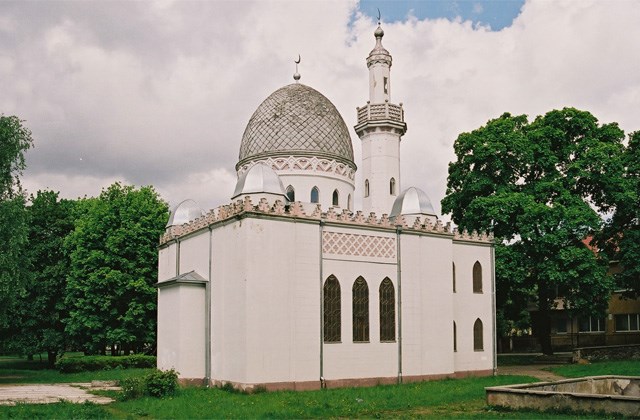Lt: Geo-slėptuvė randasi šalia Lietuvos totorių mečetės. Karmelitų kapinės, kurių teritorija dabar vadinama Ramybės parku, iki 1940 m. buvo padalintos stačiatikiams, katalikams, evangelikams liuteronams ir musulmonams. Sklypai buvo skirti laidojimui, bet nedrausta statyti maldos namų. Apie 1906 m. musulmonų valdytame sklype (0,86 ha) buvo pastatyta medinė mečetė ir 2 mediniai namai. 1930 m. Vytauto Didžiojo mirties metinių proga Kauno totorių draugija sukaupė lėšų naujai mečetei.
Maldos namai dar Vytauto Didžiojo laikais į Lietuvą atsikrausčiusiems totoriams buvo vienintelis sakralinio pobūdžio statinys laikinojoje sostinėje, skirtas pažymėti šiai datai. Mečetėje yra kvadratinio plano maldų salė su paraboliniu kupolu. Šalia stovi aukštas bokštas – minaretas, iš kurio muedzinas kviečia tikinčiuosius maldai. Tačiau panašu, kad pastarasis nebuvo naudotas pagal tradicinę paskirtį. Virš minareto ir kupolo iškelti islamiški pusmėnuliai. Mečetės projektą parengę žymūs architektai V.Michnevičius ir A.Netyksa smarkiai modernizavo rytietiškas formas. 1930 m. totorių bendruomenės prašymu tuometė Ūkio gatvė pervadinta Totorių vardu. Totorių ir Trakų g. kampe buvo ir kapinės.
II pasaulinio karo metais mečetės veikla nutraukta. 1959 m. kovo 25 d. Karmelitų kapinės buvo likviduotos. Sovietmečiu mečetėje veikė V.Dikulio cirkas, vėliau – biblioteka ir M. K. Čiurlionio dailės muziejaus sandėlis. 1972–1973 m. pastatas remontuotas pagal architekto Z. Dargio projektą. Iš pietų pusės pristatyta atvira gelžbetoninė galerija. Mečetėje buvo planuojama įkurti Rytų meno muziejų, tačiau, prasidėjus Atgimimui, planas liko neįgyvendintas. 1989 m. grąžinta tikintiesiems. 2007–2008 m. atliktas kapitalinis remontas. Kauno mečetė įrašyta į Kultūros vertybių registrą. Tai vienintelė Pabaltijo šalyse mūrinė mečetė.
En: The geocache is located near the Tartar mosque in Lithuania. The territory of the Carmelite Cemetery is now called the Peace Park. Until 1940, the area was a cemetery allocated for Orthodox, Catholic, Evangelist Lutheran and Muslim communities. The lots were designed to be used for burying the dead; however, the government did not prohibit the construction of places of worship. A wooden mosque and two wooden houses were built sometime around 1906 in the land lot (0.86 ha) owned by the Muslims. In 1930 the Kaunas Tartar Society saved enough funds to build a new mosque in the commemoration of the death anniversary of Vytautas the Great.
In the temporary capital of Lithuania, this place of worship was the only sacral building designed to commemorate the said important date and given to the Tartars who moved into Lithuania back in the times of Vytautas the Great. The mosque has a square prayer hall with a parabolic dome. The nearby minaret, where the muezzin recites the call to prayer, rises high above the mosque. However, it would seem that the minaret was not used for its traditional purpose. The Islamic crescent symbols are erected above the minaret and dome. The design of the mosque was prepared by the famous architects V. Michnevičius and A. Netyksa who significantly modernized the traditional oriental shapes. Upon the request of the Tartar community, Ūkio Street was renamed to Totorių Street in 1930. Also, a cemetery was located at the corner of Totorių St. and Trakų St.
During the Second World War the mosque was taken away from the faithful. The Carmelite Cemetery was demolished on March 25, 1959. During the Soviet times the mosque building accommodated the Circus of V. Dikulis and later on was used as a library and warehouse of M. K. Čiurlionis Museum of Art. The building was renovated during 1972–1973 according to the design of Z. Dargis. An open-spaced reinforced concrete gallery was attached on the south side of the building. There were plans to establish an Oriental Art Museum in the mosque; however, it remained incomplete after the Renaissance period started. In 1989 the mosque was returned to the believers. Major repairs were carried out during 2007–2008. Kaunas mosque was entered into the Register for Cultural Heritage. This is the only masonry mosque in the Baltic States.

Lt: Konteineris yra mikro dydžio, kuriame tikriausiai netilps jokie keliauninkai. Turėkite savo rašymo priemonę. Būkite atsargūs, nes parke beveik visada yra pašalinių žmonių. Žiemos metu gali būti sunkiau paimti konteinerį.
En: Container is micro size. It's not suitable for trackables. Have a pencil with you. Watch out for muggles - they are almost always at the park. It can be more complicated to take container during winter time.
